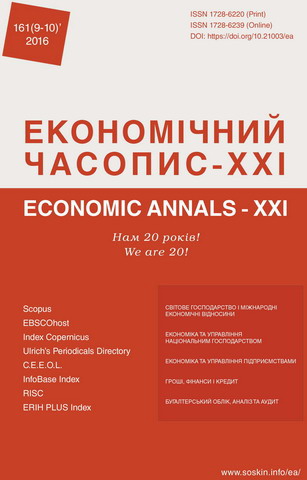Post-communist financial and economic development: cluster analysis of selected countries
Post-communist financial and economic development: cluster analysis of selected countries
Author(s): Marian Reiff, Volodymyr TokarSubject(s): Economy, National Economy, Supranational / Global Economy, Marxist economics, Economic history, Transformation Period (1990 - 2010), Post-Communist Transformation, Socio-Economic Research
Published by: Institute of Society Transformation
Keywords: Cluster Analysis; Post-communist Countries; Macroeconomic Indicators; Economic Development; Social and Economic Discrepancies;
Summary/Abstract: Purpose. The purpose of this paper is to disclose and explain disparities of social and economic development of twenty-eight postcommunist countries based on the World Bank’s macroeconomic indicators of the selected countries in 2000-2014. The paper questions whether post-communist countries are homogeneous within certain groupings and essentially different across different groupings. The differences are defined in accordance with World Development Indicators. Methods. We have applied cluster analysis to classify post-communist countries based on the long-term average of macroeconomic indicators including: GDP per capita, GDP per capita growth, Foreign direct investment net inflows (percentage of GDP), Agriculture value added (percentage of GDP), Industry value added (percentage of GDP), Total natural resources rents (percentage of GDP), and Value added (percentage of GDP), etc. The Kruskal-Wallis rank test procedure has been used to verify differences between clusters of evidence. Results. Taking into consideration the results obtained via Ward’s method we divided post-communist countries into three relatively homogeneous clusters. Cluster 1 consisted of Armenia, Azerbaijan, Georgia, Kyrgyz Republic, Moldova, Mongolia, Tajikistan, Turkmenistan, Ukraine, and Uzbekistan although Azerbaijan and Turkmenistan were assigned to Cluster 2 in the period of 2010-2014. Cluster 2 included Albania, Belarus, Bulgaria, Kazakhstan, FYR of Macedonia, Romania, the Russian Federation, Serbia, Bosnia and Herzegovina. The third cluster comprised Croatia, Czech Republic, Estonia, Hungary, Latvia, Lithuania, Poland and Slovak Republic. The Kruskal-Wallis rank test indicates statistically significant cluster differences (0.05 level of significance) for GDP per capita, GDP per capita growth, Inflation GDP deflator, Agriculture value added, Total natural resources rents, Services etc. value added. The only exception is GDP per capita growth, which has not been significantly different in 2000-2004. The conclusions are based on p-values, which have been compared with values appropriate to the level of significance ( = 0.05). Conclusions Although all countries in our research were post-communist countries, their economic trajectory after communism was far from being identical. We have found fairly consistent evidence that post-communist countries differ with respect to their social and economic dynamics and can be grouped into three relatively homogeneous clusters.
Journal: Економічний часопис - ХХІ
- Issue Year: 161/2016
- Issue No: 09+10
- Page Range: 12-17
- Page Count: 6
- Language: English

